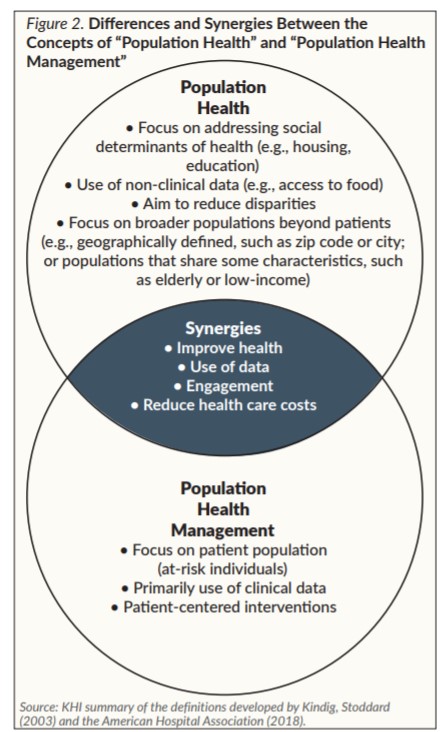Potential Benefits
Interviewees noted that there are several potential benefits that hospitals can realize by implementing population health efforts, including:
-
- Understanding the hospital’s population through utilization of socioeconomic data
- Leveraging population health work to fulfill the hospital’s role as an anchor institution, major employer and procurer of resources
- Achieving the Triple Aim, a model developed by the Institute for Healthcare Improvement, that focuses on integrated approaches to simultaneously improve patient experience of care, improve population health, and reduce costs per capita
- Reducing costs as part of an Accountable Care Organization (ACO), which is a group of health care providers who work together to provide coordinated care to their patients
- Positioning the organization to transition from a volume-based to value-based payment model, in which providers are reimbursed for outcomes rather than volume of services provided
- Meeting community benefit obligations established within section 501(c)(3) of the federal Internal Revenue Code
- Building stronger relationships with organizations in the community and collaboratively developing and implementing population health strategies.
External and Internal Drivers
Interviewees also said legal and administrative structures, policies and regulations affect hospitals’ engagement in population health. Several interviewees pointed out that CHNAs, penalties for Medicare readmissions, the movement towards value-based payment, ACOs and innovative models such as Accountable Health Communities (AHC) — in which hospitals systematically identify and address the health-related social needs of patients through screening, referral, and community 2 September 2018 April 2018 Building Interest in Population Health Among Hospitals and Health Systems navigation services — helped to further strengthen the foundation for hospitals’ work in population health. On the other hand, some interviewees said that there is limited number of financial benefits and structures currently existing to support hospitals’ work in population health.
Another external driver brought up by the interviewees was the role of state-level guidance and policies in advancing population health efforts. For example, the state of Ohio instructed hospitals and local health departments to submit one joint community health assessment (CHA), and also established similar three-year cycles for local health districts and tax-exempt hospitals to conduct CHAs/CHNAs. Another example of a state-level innovation offered by an interviewee highlighted the global payment model utilized in Maryland. Under this model, a hospital’s total revenue from all payers is set at the beginning of the year, which encourages health care providers to address social determinants of health in order to keep people healthier.
Although the interviewees recognized the impact of these policies and programs as external drivers of hospitals’ engagement in population health, several internal drivers were seen by several interviewees as key motivators for advancing population health efforts. These drivers include buy-in from hospital leadership; staff positions dedicated to population health; “the bottom line” or a financial outcome influenced by social determinants of health; creation of a single office to coordinate population health; and a consistent approach toward population health across payers.
Barriers to Addressing Population Health
Many interviewees pointed out that hospitals realize the transition toward value-based care is underway, but barriers to embarking on population health efforts remain.
-
- There is no consensus on one single definition of population health, and differing terminologies across sectors have added further confusion.
- Although consolidation across payers is occurring as a byproduct of the ACA, the transition has been slow.
- The reimbursement structure for working on social Building Interest in Population Health Among Hospitals and Health Systems September 2018 3 determinants of health is not mature and widely understood.
- Population health is a complex topic and many hospitals feel that addressing root causes of poor health outcomes is not within their control or influence.
- Work in population health requires additional competencies that health care providers might not fully possess.
- Financial challenges are among top concerns for hospitals, especially rural hospitals. Some hospitals might think that they “don’t have enough margin to invest in the kinds of resources needed to do real population health work.”
- In general, conservative states may have a tendency to emphasize the personal responsibility of individuals and their behavioral choices, rather than the role of social and built environment on health, which in turn affects policymaking.
Population Health Related Activities Undertaken by Hospitals
According to interviewees, some hospitals started their population health work by addressing food insecurity and housing instability. For example, one hospital partnered with a city to create a pool of subsidized housing. Another covered housing costs for homeless populations to improve their health.
Hospitals’ interest in screening patients for unmet social needs has increased recently. Typically, these assessments include a series of questions aimed at evaluating social and economic circumstances (e.g., food insecurity, housing instability, utility needs) that can affect patients’ health. Some hospitals have incorporated screeners into their electronic medical records. However, some hospitals have been struggling with how to effectively use information collected from screeners to connect individuals to social services.
One interviewee noted that their health system purchased a software application that included a regularly updated list of social services available in the area, and which allowed for the creation of a feedback loop, so the hospital knew when someone accessed a service. Another interviewee highlighted their health system’s efforts related to supporting the development of a comprehensive community center that provides child care, legal services, health care services, and other supports. “All of those efforts (CHNAs, ACA, ACO, AHC) work to move toward more value-based payment and health systems assuming risk and being accountable for the health of their populations.” —Interview Respondent
Furthermore, several interviewees said that hospitals have been interested in developing maps of their catchment areas to understand the social and economic conditions in their communities.
Other population health activities undertaken by hospitals included:
-
- Conducting collaborative CHNAs and Community Health Improvement Plans
- Developing institutional policies that require senior leadership to engage in civic affairs
- Reviewing data of preventable emergency department utilization along with census tract demographics data and population health metrics
- Engaging in community investments via community development financial institutions
- Supporting healthy food financing and a development of food systems.
Looking Ahead
The interviewees provided a variety of suggestions for hospitals interested in advancing population health efforts:
-
- Ensure that the population health definition used by a hospital includes a focus on addressing social determinants of health (e.g., housing, access to healthy food, education) and health disparities, and focuses on populations beyond patients
- Establish designated staff to coordinate a hospital’s population health activities
- Include socioeconomic data within electronic health records
- Engage with partners such as local health departments, community organizations and university extension offices around population health efforts
- Conduct a joint CHNA with a local health department
- Use available resources (e.g., County Health Rankings, CDC Community Guide) to identify strategies for advancing population health
- Identify ways for capturing and evaluating benefits related to population health work.
Interviewees also highlighted several strategies that can be used by organizations that want to assist hospitals’ efforts in population health:
-
- Assist hospitals with identifying financial streams for supporting their work in population health
- Find and recruit champions from hospitals who will advocate for population health
- Build relationships with organizations that work closely with hospitals, such as state hospital associations
- Build a shared vision and goals rather than approaching hospitals with financial requests
- Convene stakeholders (e.g., hospital staff, leadership, boards) to identify their needs and priorities
- Lead or participate in conferences discussing hospital engagement in population health.
Additionally, the interviewees noted the value of peer learning and suggested establishing cross-learning opportunities for organizations interested in assisting hospitals with advancing their population health efforts.

